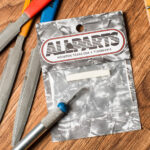Stevie Ray Vaughan’s guitars, legendary instruments wielded by a true blues master, continue to fascinate guitar enthusiasts. At guitarplayers.net, we explore the stories behind these iconic axes, from his beloved “Number One” Stratocaster to lesser-known gems, examining their modifications, history, and ultimate fate. Discover how SRV’s unique style shaped these guitars and cemented his legacy as one of the greatest guitarists of all time, influencing countless players and inspiring a generation of blues aficionados.
1. What Was Stevie Ray Vaughan’s First Guitar?
Stevie Ray Vaughan’s first guitar was a 1957 Gibson ES-125T 3/4 Sunburst Archtop. This was the instrument on which he began to develop his formidable guitar skills. His brother, Jimmie, gifted Stevie this guitar, which their father had originally given to Jimmie.
The Gibson ES-125T 3/4, notable for being produced starting in 1957, had several characteristics. The instrument had 22 frets, two F-holes, a raised pickguard, and volume/tone controls. Its serial number was U142221. Stevie played this guitar so often that it had numerous scratches and dents. Until he acquired the next guitar on this list, it was his primary guitar. This guitar served as the foundation for SRV’s early exploration of music, setting him on the path to becoming a guitar legend.
2. What Was the Story Behind SRV’s “Jimbo” Guitar?
SRV’s “Jimbo” guitar, a 1951 Fender Broadcaster (Nocaster), also came from his brother, Jimmie, marking it as his first proper electric guitar. This gift played a crucial role in Stevie’s progression as a guitarist.
There are different versions of how Stevie acquired the guitar. According to one story, SRV discovered the guitar disassembled in a cupboard at their house. He reassembled the guitar and was allowed to keep it by Jimmie. According to another, Jimmie gave him the guitar to stop him from always borrowing guitars. The guitar underwent various modifications after SRV obtained it. The tone control was modified to act as a second volume control, and the name “Jimbo” was carved into the back of the body. According to Reverb contributor Casey Hopkins, he also removed the finish and added a neck pickup.
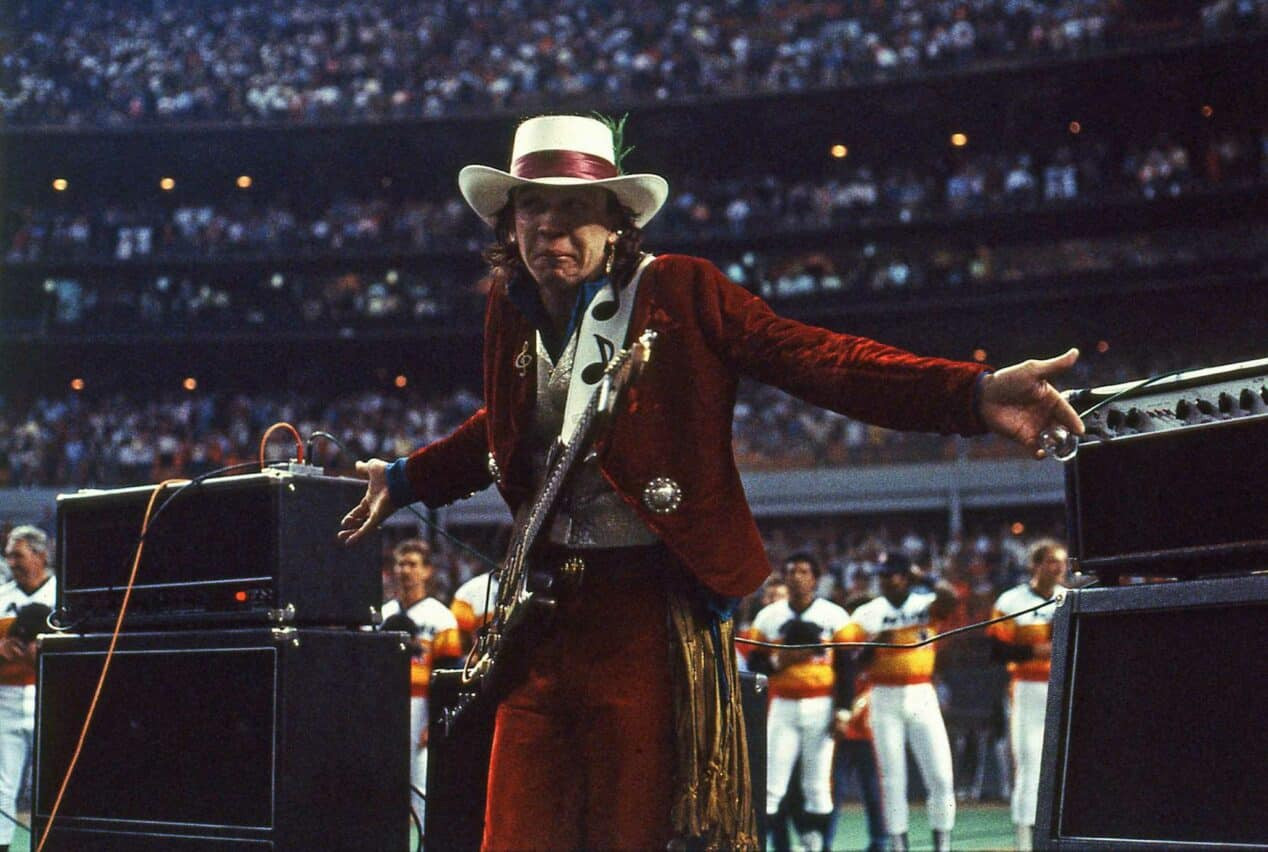 SRV Jimbo Guitar
SRV Jimbo Guitar
The precise year and model of this guitar have been the subject of speculation. The primary theory is that it’s a Nocaster, a name given to a select group of Telecasters manufactured during Fender’s transition from Broadcaster to Telecaster. Even if SRV did not own it, this would make it extremely valuable today. On our blog, you can read more about Nocasters in our post about the History of the Fender Telecaster.
Other theories claim it’s a 1952 Telecaster with the headstock logo removed. Hopkins believes it is a 1951 Esquire that only had a bridge pickup originally. SRV traded this guitar in 1971 for a 1963 Epiphone Rivera, regardless of its year or model. He later regretted trading it and publicly requested its return. Unfortunately, no one ever came forward, and the guitar was never returned to him. The guitar was rediscovered in the 2000s. Loni Specter of the Los Angeles Amp Show saw a studio musician playing it and recognized it years later after reading about it in a book. The guitar was eventually purchased, authenticated by Jimmie, toured around at various shows and museums, and sold for $250,000 in 2008.
3. What Made SRV’s “Number One” Stratocaster So Special?
SRV’s “Number One” Stratocaster, his main guitar, holds a special place in guitar history due to its unique characteristics and its central role in Vaughan’s career. He obtained it in the early 1970s through a trade with Ray Hennig, a guitar shop owner in Texas. Hennig claimed Christopher Cross had traded the guitar a few weeks earlier and that it was the worst guitar he had ever had in the shop.
The guitar is actually a partscaster. SRV is rumored to have taken out the pickups and seen a 1959 stamp on them, believing it was a 1959. However, when the guitar was disassembled in the 1980s, a 1963 stamp was found on the body and a 1962 stamp was found on the neck. Originally, the guitar had a white pickguard, which was replaced with a black one that had SRV’s initials stickered on it. It also featured a left-handed tremolo bar, a modification that has gained popularity since then.
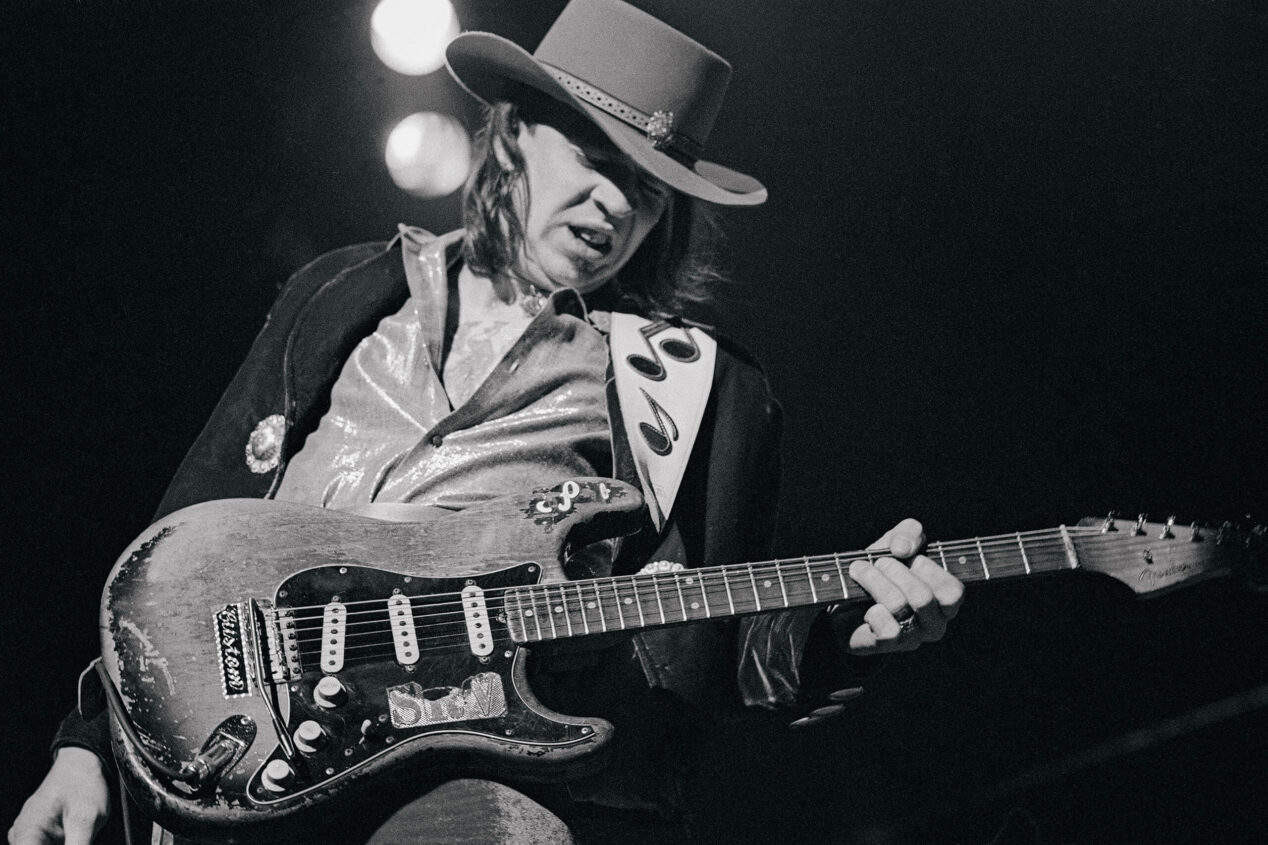 SRV Number One
SRV Number One
The neck was replaced in the mid-1980s. SRV was a very heavy-handed player, so he wore through frets quickly. As a result of his playing, the fretboard deteriorated, necessitating frequent fret changes. Later in 1990, a piece of stage equipment fell on SRV’s guitars. The neck was broken and had to be replaced again. However, after his death a few weeks later, the original neck was reattached to preserve the guitar’s original condition. The guitar’s history and modifications contributed to its iconic status, making it a symbol of SRV’s distinctive sound and style.
4. How Did Stevie Ray Vaughan Acquire His “Lenny” Stratocaster?
Stevie Ray Vaughan’s “Lenny” Stratocaster was gifted to him in 1980 by his wife, Lenora, and their friends, marking a significant moment in his personal and musical life. The guitar is a 1963 or 1964 model.
He’d seen the guitar in a pawnshop but couldn’t afford it. Lenora convinced them to pool their money and buy it for him as a gift, and the guitar was his a few months later. It came from the factory with a three tone sunburst, but the previous owner gave it a natural finish and inlaid a mandolin-style pickguard below the bridge.
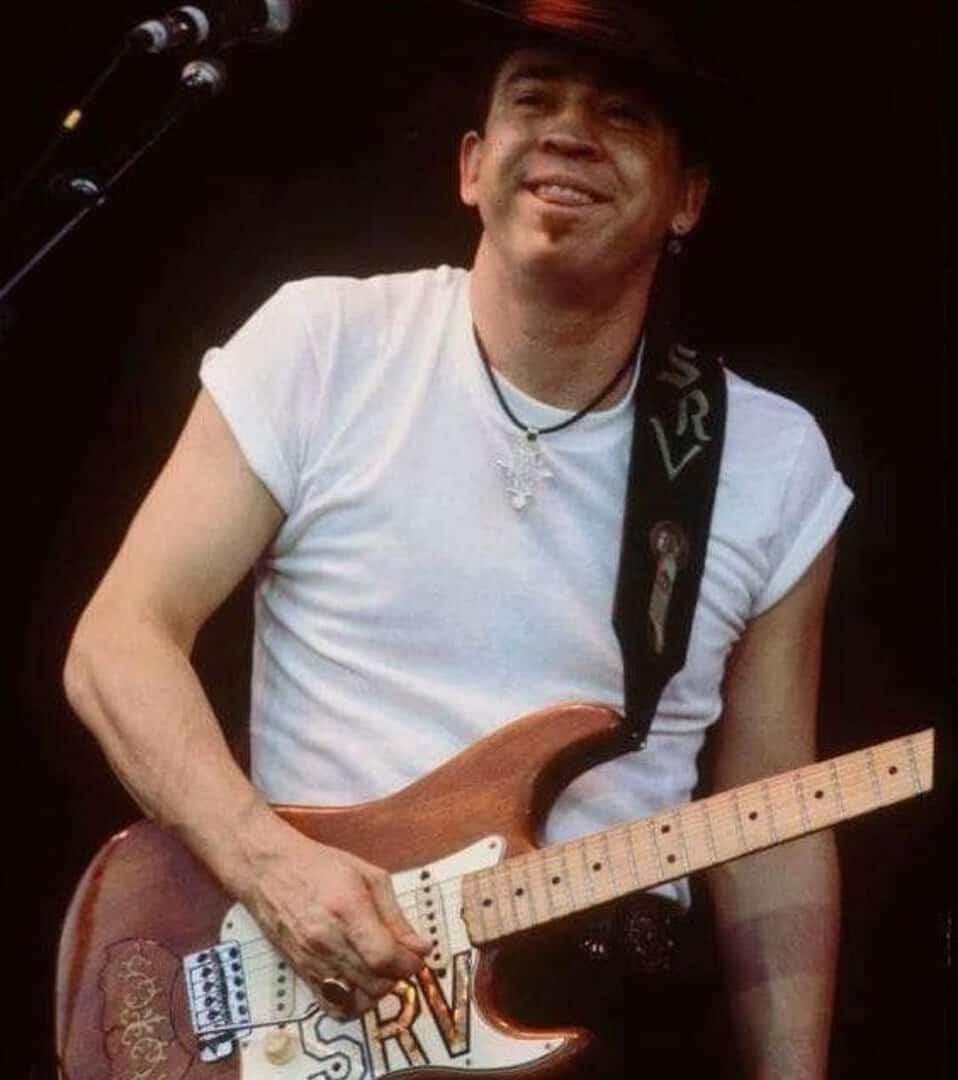 SRV Lenny Strat
SRV Lenny Strat
As for modifications by SRV, he added his initials to the pickguard, swapped out the neck for one with a rosewood fretboard in 1981, and added Mighty Mite saddles. He also had Mickey Mantle sign the back of the guitar in 1985. Other than that, the guitar is as-is from the original owner. The guitar was eventually purchased by Guitar Center in 2004 and can be found at the Guitar Center in Austin. This gesture of love and support further solidified Vaughan’s connection to his instrument.
5. What Happened to SRV’s “Yellow” Stratocaster?
SRV’s “Yellow” Stratocaster faced an unfortunate fate, being stolen in 1985 and never recovered. This loss added a layer of mystique to the guitar’s history.
Like “Number One,” this is another guitar from a professional that ended up in a guitar shop in Texas. It was owned by Vince Martell of Vanilla Fudge before SRV purchased it in the early 80s. The most odd thing about this guitar is that it had a single neck pickup, which is odd for a Strat. Supposedly Martell had routed out the body to stuff it full of humbuckers. The owner of the guitar shop decided to cover up the routing with a pickguard instead, leaving it with a single neck pickup. He made similar modifications as he did with “Lenny,” adding his initials to the pickguard and a set of Mighty Mite saddles.
Based on some photos, it seems like the guitar was restored to its original three pickup state in 1985. However, it’s difficult to tell and SRV didn’t really talk about the guitar much, so it’s hard to conclusively say. There are rumors it is at the Hard Rock Cafe in Las Vegas, but no one has ever been able to confirm it—so it seems unlikely. The guitar remains a symbol of the unpredictable nature of fame and the sometimes harsh realities faced by musicians.
6. What Modifications Did SRV Make to His “Red” Stratocaster?
SRV’s “Red” Stratocaster underwent minimal modifications, maintaining much of its original character. As with most guitars on this list, SRV bought this guitar from a shop in Texas in the early to mid 80s.
It started out as a sunburst Start, likely repainted by the original owner. This guitar was relatively unmodified, being completely untouched until 1986. The neck was taken off and used to replace the neck one “Number One,” and the replacement neck was seemingly a knockoff left handed neck. He also added his initials to the pickguard. Outside of that, the guitar is a stock 1962 Stratocaster. In 1990, it was damaged in the same incident that damaged “Number One.” The neck was damaged, and it was replaced with a new rosewood neck from Fender. The guitar’s limited alterations reflect SRV’s appreciation for the instrument’s inherent qualities.
7. What Was Unique About SRV’s Hamiltone “The Main” Stratocaster?
SRV’s Hamiltone Lurktamer Stratocaster “The Main” stood out due to its custom construction and unique features, setting it apart from his other guitars.
This guitar was commissioned by Billy Gibbons of ZZ Top as a gift to SRV, built by custom guitar builder James Hamilton. SRV got the guitar in 1984. It has neck through construction, a two-piece maple body, and a three-piece neck. There is an abalone inlay across the fretboard splaying out SRV’s name. It also originally came with EMG pickups and Gibson style knobs. The EMGs were swapped out for standard Strat single-coils, supposedly after they got wet and stopped working during the filming of Couldn’t Stand the Weather. The knobs were also changed to regular Strat-style knobs around this point as well. The guitar’s unique design elements highlighted Vaughan’s willingness to explore new sonic territories.
8. What Is Known About SRV’s “Scotch” Stratocaster?
SRV’s “Scotch” Stratocaster remains somewhat enigmatic, with limited information available about its history and usage. SRV bought this guitar from a shop at some point 1985 and was a fairly standard 1961 Strat.
Information is scarce, but the guitar was allegedly supposed to be given away as a prize. However, SRV liked the guitar so much that he decided to offer up a different one instead. Though it’s called “Scotch,” the guitar was most likely olympic white originally since it’s a 1961. The finished yellow, leaving the butterscotch looking finish that can be seen today. There was also a custom red and black pickguard added in the mid 80s with his initials. Surprisingly, there’s little other information about this guitar. SRV used it somewhat often though, being one of his main backups. Despite its mysterious past, the guitar served as a reliable backup for Vaughan.
9. What Was Special About SRV’s Custom “Charley” Guitar?
SRV’s custom “Charley” guitar, built by Charley Wirz, was a unique creation made from various parts. This was a custom guitar built by Charley Wirz, who owned a shop in Texas where SRV purchased numerous guitars.
The guitar is a bit of a Frankenstein, made mainly with DiMarzio parts. It has a white Strat-shaped body, rosewood neck, lipstick pickups, and two controls (tone and volume) instead of the usual three. It also has a hula girl sticker on the back of the body. This guitar didn’t get used a whole lot, but he did use it from time to time. He used it on “Life Without You,” which was a tribute to Wirz. The guitar’s unconventional design reflected Vaughan’s willingness to experiment with different sounds and styles.
10. What Was the Story Behind SRV’s Designed Prototype Guitar?
SRV’s designed prototype guitar represented his vision for a custom instrument, though it never reached production.
SRV designed this guitar himself in 1982, and he worked with various experts to try and make it a reality. By 1984, Gordon van Ekstrom had agreed to help him get it off the ground and possibly into production. The most unique thing about this guitar is its shape, which is Telecaster-like but with a half circle cutout of the body behind the bridge. Interestingly enough, this shape is actually fairly similar to the body used for Abasi’s Concepts’ Space-T. SRV also wanted to have the pickups in the shape of his initials. They reached out to Seymour Duncan, but they said the idea was not possible. This guitar was used once live and never used live again. It never reached production, and the original prototype was never finished either. The guitar’s innovative features offered a glimpse into Vaughan’s creative mind.
11. Why Was Stevie Ray Vaughan Seen Playing Tokai Guitars?
Stevie Ray Vaughan’s association with Tokai guitars stemmed from a potential endorsement deal and the guitars he was given by the company. On the cover of SRV’s album Texas Flood, he can be seen playing a Tokai Springy Sound Strat.
According to those around him, SRV was never known to have bought or played any Tokai instruments. So where exactly did this guitar come from, and why was he depicted with it on the cover? A book by Craig Hopkins contains a photo of SRV playing the Tokai live, so he did use it at least once. Hopkins also claims there was an endorsement deal in the works, explaining why he was using the guitar. There is a signed contract of this endorsement, but it appears to be forged according to experts. There’s also a fairly infamous Tokai catalog that featured SRV playing various Tokais on the cover, and it’s likely the forged contract was why that catalog happened. SRV was apparently very upset at the marketing campaign. On top of that, there have since been other Tokai Strats auctioned off that are confirmed to be his, one of which was a Tokai AST. This seems to be one of the guitars featured in the Tokai catalog. It seems the most likely scenario is that SRV was given some guitars by Tokai as a free endorsement. He played them a bit, was pictured with them, and they ended up on the album cover and in the catalog. The guitars became part of Vaughan’s diverse collection, showcasing his openness to different brands and styles.
12. What Significance Did the Epiphone Riviera Hold in SRV’s Career?
The Epiphone Riviera played a significant role in SRV’s early career, marking a transition from his initial guitar preferences to his eventual love for Stratocasters.
As mentioned earlier, this is the guitar SRV traded the “Jimbo” Telecaster for. It was relatively early in his career, and he had yet to realize his love for Stratocasters. He was looking for “the” guitar for him and ended up loving this one, resulting in the trade. He used it live in many of his early bands like Blackbirds and Nightcrawler. Even after realizing he preferred Strats, he would use the guitar on stage. And after he stopped using it frequently, it still stayed in his collection. An interesting note is that he changed the pickguard configuration multiple times. Sometimes it would appear with a single pickguard, and sometimes without. It ended up with a double pickguard at one point as well. It’s unknown why SRV was seemingly undecided on the pickguard.
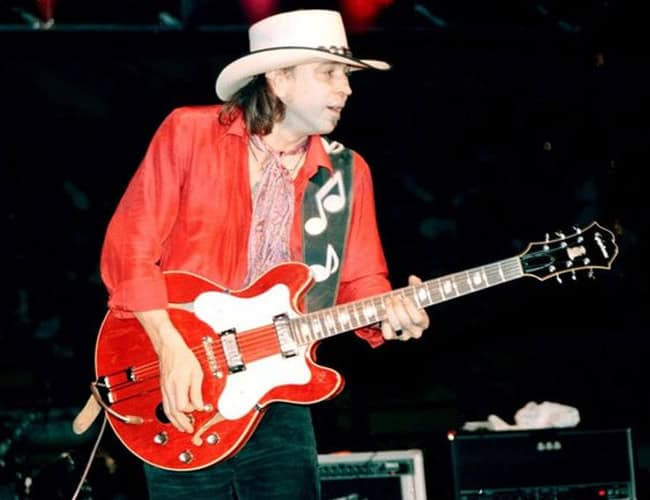 SRV Epiphone Riviera
SRV Epiphone Riviera
While this might not be the most interesting guitar SRV owned, it’s one he clearly loved and also played an important part in the story of his “Jimbo” telecaster. The guitar symbolized Vaughan’s evolving musical tastes and his search for the perfect instrument.
13. What Was the Story Behind SRV’s 1930 National Duolian Resonator?
SRV’s 1930 National Duolian Resonator held a special place in his collection due to its connection to blues history and its personal significance to Vaughan. Last but not least is a 1930s National Duolian.
He believed that the guitar was once owned by Blind Boy Fuller, an early blues guitarist. The guitar was given to him by a roadie, Byron Barr, who bought it in 1981. SRV claimed the guitar was a 1928 dobro, but the supposed serial number (C704) indicates it’s actually a Duolian—a model that wasn’t manufactured until 1930. Regardless, the guitar was said to be a favorite of SRV and a prized possession. He was known to take the guitar with him on tour, regularly playing it backstage and in his free time. The guitar represented Vaughan’s deep appreciation for the roots of blues music and his connection to the genre’s pioneers.
14. What Strings Did Stevie Ray Vaughan Use On His Guitars?
Stevie Ray Vaughan was known for using heavy gauge strings on his guitars to achieve his powerful tone and facilitate his aggressive playing style. According to Guitar Player Magazine, SRV typically used GHS Nickel Rockers strings, with gauges of .013, .015, .019, .028, .038, and .058. These heavier strings required significant finger strength and contributed to his signature sound. His choice of strings was an essential part of his distinctive tone and playing technique.
15. Did Stevie Ray Vaughan Use a Heavy Pick?
Stevie Ray Vaughan favored using Fender extra heavy picks, which complemented his aggressive playing style and contributed to his powerful sound. According to Jas Obrecht from Guitar Player Magazine, SRV preferred thicker picks for their durability and ability to produce a strong attack. These picks allowed him to dig into the strings and produce his signature tone. The use of heavy picks was a crucial element in achieving Vaughan’s dynamic and expressive playing.
16. What Amps Did Stevie Ray Vaughan Typically Use?
Stevie Ray Vaughan primarily used Fender and Dumble amplifiers to create his iconic tone. His setup often included Fender Vibroverbs and Super Reverbs, known for their clean and responsive sound. He also used Dumble Overdrive Special amplifiers, which provided additional gain and sustain. SRV’s amp choices were crucial in shaping his signature sound, providing the foundation for his dynamic and expressive playing. These amps allowed him to achieve the powerful and nuanced tones that defined his music.
17. What Effects Pedals Were Essential to Stevie Ray Vaughan’s Sound?
Stevie Ray Vaughan incorporated several effects pedals into his setup to enhance his guitar tone. A key element was the Ibanez Tube Screamer, which he used to boost his signal and add overdrive. According to Guitar World, SRV also utilized a Vox Wah pedal for expressive tonal variations and a Fuzz Face for added distortion. These pedals, combined with his amps and guitars, were essential in creating the unique and recognizable sound that defined his music. His use of effects pedals added depth and character to his playing.
18. How Did Stevie Ray Vaughan’s Gear Influence His Playing Style?
Stevie Ray Vaughan’s choice of gear, including his guitars, strings, picks, amps, and effects pedals, significantly influenced his playing style. His heavy gauge strings and thick picks contributed to his aggressive attack and powerful tone. His Fender and Dumble amps provided a clean and responsive foundation, while his effects pedals added depth and character to his sound. According to an interview in Guitar Player Magazine, SRV’s equipment choices allowed him to express himself fully and create his signature sound. His gear choices were integral to his distinctive and influential playing style.
19. What Is the Best Way to Replicate Stevie Ray Vaughan’s Guitar Tone?
Replicating Stevie Ray Vaughan’s guitar tone involves a combination of gear and technique. Start with a Stratocaster-style guitar, heavy gauge strings, and thick picks. Use Fender or Dumble amplifiers, and incorporate an Ibanez Tube Screamer for overdrive. Focus on developing a strong and dynamic playing style, with an emphasis on blues phrasing and vibrato. According to guitar instructional videos by Jorma Kaukonen, understanding SRV’s gear and technique is essential for capturing his iconic sound. With the right equipment and practice, you can come close to achieving Stevie Ray Vaughan’s legendary guitar tone.
20. Where Can I Learn More About Stevie Ray Vaughan’s Guitars and Gear?
To learn more about Stevie Ray Vaughan’s guitars and gear, explore resources such as guitarplayers.net, which offers detailed articles and information on his equipment. Books like “Stevie Ray Vaughan: Day by Day, Night After Night” by Craig Hopkins provide in-depth insights into his life and career. Guitar Player Magazine and Guitar World often feature articles and interviews about SRV’s gear. These resources offer a wealth of knowledge for guitar enthusiasts looking to understand and emulate Stevie Ray Vaughan’s iconic sound.
Stevie Ray Vaughan’s influence on the world of guitar playing is undeniable, and his guitars are a significant part of his legacy. To delve deeper into the techniques and styles of guitar playing, guitarplayers.net offers a wealth of resources. Whether you’re a beginner eager to learn the basics, an intermediate player aiming to refine your skills, or an advanced guitarist looking for inspiration, our site provides lessons, reviews, and community forums to support your musical journey. Explore our extensive collection of guitar tabs and sheet music to play your favorite songs, and connect with fellow guitar enthusiasts in our online community. Visit guitarplayers.net today to enhance your guitar playing experience.
Address: 1140 Boylston Street, Boston, MA 02215, United States
Phone: +1 (617) 747-2261
Website: guitarplayers.net
